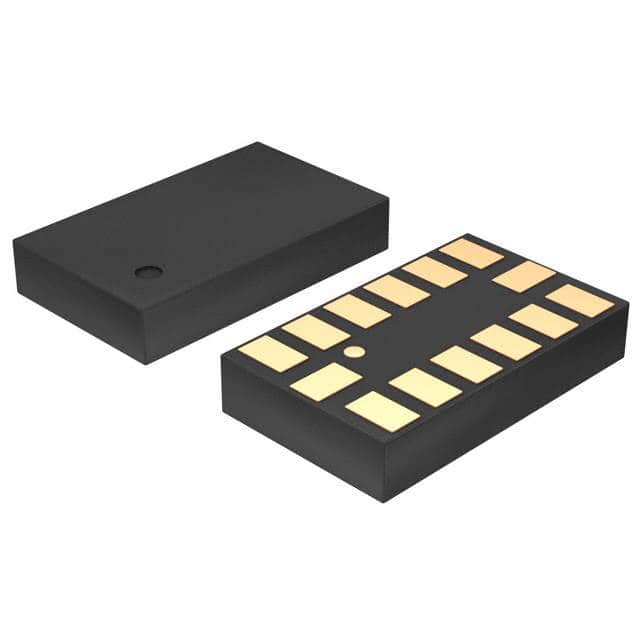LIS302DLHTR
Product Overview
The LIS302DLHTR belongs to the category of motion sensors and is commonly used in various electronic devices for detecting motion and orientation. This sensor is known for its compact size, low power consumption, and high accuracy. The package includes the sensor itself along with essential documentation for integration. The essence of the LIS302DLHTR lies in its ability to provide precise motion detection and orientation sensing in a small form factor. It is typically packaged in quantities suitable for production runs.
Specifications
- Operating Voltage: 2.16V to 3.6V
- Sensing Range: ±2g/±8g
- Output Data Rate: 100 Hz to 1 kHz
- Interface: I2C/SPI
- Package Type: LGA-14
Detailed Pin Configuration
The LIS302DLHTR features a 14-pin configuration, including pins for power supply, ground, communication interface, and sensor output. The pinout is as follows: 1. VDD - Power Supply 2. GND - Ground 3. SCL/SDI - Serial Clock/Input Data (I2C/SPI) 4. SDA/SDO - Serial Data/Output Data (I2C/SPI) 5. CS - Chip Select (SPI) 6. SA0 - I2C Address Selection 7. INT1 - Interrupt 1 8. INT2 - Interrupt 2 9. NC - Not Connected 10. XOUT - X-axis Output 11. YOUT - Y-axis Output 12. ZOUT - Z-axis Output 13. ST - Self-Test 14. NC - Not Connected
Functional Features
The LIS302DLHTR offers high-resolution motion sensing capabilities, enabling accurate detection of acceleration and tilt. It incorporates built-in self-test functionality for diagnostic purposes and provides interrupt outputs for event-driven applications. Additionally, it supports both I2C and SPI communication interfaces, offering flexibility in system integration.
Advantages and Disadvantages
Advantages
- Compact form factor
- Low power consumption
- High accuracy
- Flexible communication interfaces
Disadvantages
- Limited sensing range compared to some alternatives
- Higher cost compared to similar sensors
Working Principles
The LIS302DLHTR operates based on the principles of micro-electromechanical systems (MEMS) technology. It utilizes microscopic structures to detect changes in acceleration and orientation, converting these physical movements into electrical signals. These signals are then processed to provide meaningful data about the device's motion and position.
Detailed Application Field Plans
The LIS302DLHTR finds extensive use in various applications, including: - Mobile devices for screen orientation and gesture recognition - Gaming controllers for motion-based input - Wearable devices for activity tracking and gesture control - Industrial equipment for vibration monitoring and impact detection
Detailed and Complete Alternative Models
Some alternative models to the LIS302DLHTR include: - LIS3DH: Offers extended sensing range and lower power consumption - ADXL345: Provides higher sensing range and lower cost - MPU-6050: Integrates gyroscope functionality for comprehensive motion sensing
In conclusion, the LIS302DLHTR is a versatile motion sensor that excels in providing accurate motion and orientation sensing in a compact form factor. Its high resolution and flexible interface options make it suitable for a wide range of applications, from consumer electronics to industrial equipment.
Word count: 514
Lista 10 Vanliga frågor och svar relaterade till tillämpningen av LIS302DLHTR i tekniska lösningar
What is the LIS302DLHTR?
- The LIS302DLHTR is a three-axis linear accelerometer that can measure acceleration in three dimensions.
What are the typical applications of the LIS302DLHTR?
- It is commonly used in applications such as motion-activated functions in mobile devices, gaming controllers, and industrial equipment.
What is the operating voltage range of the LIS302DLHTR?
- The operating voltage range is typically between 2.16V and 3.6V.
How does the LIS302DLHTR communicate with a microcontroller?
- It typically communicates using an I2C or SPI interface.
What is the measurement range of the LIS302DLHTR?
- The measurement range is typically ±2g, ±8g, or ±16g, depending on the configuration.
Can the LIS302DLHTR be used for tilt sensing applications?
- Yes, it can be used for tilt sensing by measuring the acceleration due to gravity in different axes.
What are the key features of the LIS302DLHTR?
- Some key features include low power consumption, high resolution, and embedded self-test.
Is the LIS302DLHTR suitable for battery-powered devices?
- Yes, its low power consumption makes it suitable for battery-powered devices.
What are the main considerations for PCB layout when using the LIS302DLHTR?
- Proper grounding, minimizing noise, and ensuring adequate decoupling are important considerations for PCB layout.
Are there any specific calibration requirements for the LIS302DLHTR?
- Calibration may be required to compensate for offset and sensitivity variations, especially in high-precision applications.
Feel free to ask if you need further information on any of these questions!


